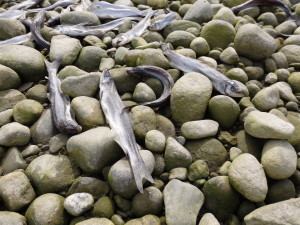
Hooligan fishing is a tradition for many people in the Upper Lynn Canal. But this spring, those who fish in the Chilkoot had disappointing results. Researchers say the mysterious fish seem to have turned right instead of left into the Taiya, near Skagway, and there’s no way to know exactly why.
“I didn’t catch any on the Chilkoot side, but I caught some at Jones Point,” says lifelong Haines resident Sonny Williams. “I caught ten gallons and that was it.”
Williams says he usually catches 20 to 30 gallons of hooligan each spring. The small herring-like fish is traditionally used for oil and smoking. He says the only other times he’s seen the run this low in the Chilkoot is when the lake has been frozen.
“It was a lot lower than the previous four years that we have data on,” said Meredith Pochardt, executive director of Takshanuk Watershed Council.
Takshanuk is the only group that monitors hooligan in the Upper Lynn Canal. They’ve monitored the runs in the Chilkoot from 2010-2012 and in 2014. This year, they estimate the run was about 300,000. Last year, it was between three and four million. In 2011, it was about 12 million.
So why did the hooligan cross to the other side? Why a big run in the Taiya, and not the Chilkoot? Williams, the hooligan fisherman, thinks he knows. He says he was watching the hooligan as they swam north.
“I watched them come around Battery Point and get right in the river there. And we’re like ok, they’re gonna show up,” Williams said. “They started trickling off and all of a sudden, the pounding at the ferry terminal had a definite effect on them moving out of here.”
Williams says he watched the hooligan turn around near the ferry terminal. A new ferry dock has been under construction since April. The State Department of Transportation says they have not heard any complaints.
Hooligan are not well-researched like salmon and halibut. Brad Ryan, director for Southeast Alaska Watershed Coalition, says Alaska Fish and Game doesn’t monitor hooligan because they’re not as economically important as other fish. But they are traditionally important to subsistence fishermen in the Upper Lynn Canal.
Since there’s so little research on hooligan, it’s hard to predict what the little fish will do next spring. Haines locals hope the Chilkoot will see a stronger run. And Skagway locals hope their hooligan luck continues.
